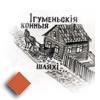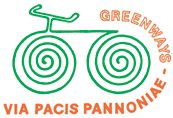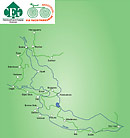Menu
Production
VIA PACIS PANNONIAE GREENWAYS - PEACE TRAIL
Serbia, Croatia
Trail presentation
The Via Pacis Pannoniae - Pannonian Peace Trail is a concept for creating a greenway along the Danube River, which crosses the territories of the Republic of Serbia and the Republic of Croatia. Two local greenway routes have been established, the first in Vojvodina connecting Novi Sad to Cenej and the second connecting the cities Osijek in Croatia and Sombor in Vojvodina (Serbia). Destinations along the routes are places of historic and cultural importance and include many traditional farms. The greenway runs through the natural marsh reservations of "Kopacki rit" (near Osijek, Croatia), the special Gornje Podunavlje nature reserve (near Sombor, Vojvodina, Serbia), the "Fruska gora" National Park (near Novi Sad, Vojvodina, Serbia), as well as many other countryside heritage sites.
The greenway network contributes to cross-border cooperation, building tolerance and democracy and helping demilitarise this once war-engulfed region. The route represents a communication and cooperation bridge connecting the regions of Pannonia (Baranja and Slavonia in Croatia and Vojvodina in Serbia).
The project is based on a partnership involving organisations from Southern and Eastern Europe (Green Network of Vojvodina - GNV, Serbia, leading organisation; Organizacija za gradjanske inicijative - OGI, Osijek, Croatia; Zeleni Osijek - ZO, Osijek, Croatia; Centar za Mir, Nenasilje i Ljudska Prava - CMNLP, Osijek, Croatia), an organisation from Central Europe (Nadace Partnerstvi - the Czech Environmental Partnership Foundation), and a non-profit organisation from the United States (the Project for Public Spaces - PPS).
The greenway from Novi Sad in Serbia runs along the Danube, linking Novi Sad to Futog and Backa Palanka. Next, it crosses the Danube and the Serbian-Croat border to Croatia. In Croatia, the greenway passes through Ilok and Vukovar to reach Osijek with its surroundings (including the marshes of Kopacki Rit). The greenway arches back to Serbia, across the Danube, to reach Apatin and Sombor. The route continues on to Subotica, and returns to Novi Sad (Cenej District).
The first 80 km section of the Via Pacis Pannoniae greenway, connecting the towns of Osijek (Croatia) and Sombor (Vojvodina-Serbia), is already signed-posted and arranged with the resting points. The route stretches through some of the best preserved nature areas on the Danube River, including Kopački Rit Nature Park and the Gornje Podunavlje Nature Reserve, and links together many different ethnic communities, which still live in a traditional way. Travelling along the route, visitors can enjoy local cuisine, discover traditional handicrafts, explore cultural and historic sites, and take advantage of boating, horse carriage rides and photography opportunities.
The bicycle route in Osijek begins on the right side of the road heading north, just beyond the bridge over the Drava River. The starting point in Sombor is located by the Saint Florian monument in Batina street.
The Osijek-Sombor Pannonian Peace trail began as a project called "The Cross Border Cooperation and Reconciliation" financed and supported by CRS (Catholic Relief Services) and USAID (United States Agency for International Development). Several organizations assisted with the coordination of activities, including the Ecological Association, Green Osijek and Green Network of Vojvodina, local authorities of Osijek and the Municipality of Sombor.
The idea of developing a network of bicycle routes within the Pannonian regions of Croatia, Serbia and Hungary, under the banner of the Pannonian Peace Trails / Via Pacis Pannoniae, was conceived in 2004 by the Green Network of Vojvodina and Green Osijek, and developed initially as community-based initiatives supported by the Balkan Trust for Democracy. The motivation for the Pannonian Peace Trail is to connect people, preserve natural and cultural values for sustainable development in the Danube region. The bicycle route along the Osijek-Sombor Pannonian Peace Trail is the third cross-border peace route in the world!
Main tourist attractions and towns along this trail (nature and cultural heritage etc.)
Kopački rit Nature Park
A wetland area in north-east Croatia, lying at the confluence of the Drava and Danube Rivers, is one of Europe's largest fluvial wetland plains, extending over 23,000 hectares. As many as 285 bird species are to be found here, including endangered species such as the eagle (Haliaeetus Albicilla), the black stork and the steppe falcon. Many other animals can be frequently seen in the marsh such as herds of deer, wild boars and otters.
Gornje Podunavlje Special nature reserve
Gornje Podunavlje is the best preserved marsh located along the Danube River in Serbia, covering 19,648 hectares. Two large marshes in Monoštorski and Apatinski contain rich biological diversity; as well as traditional and cultural heritage sites. While watching the abundant wildlife and rare birds, visitors can meet some of the last remaining fresh-water fishermen. The Gornje Podunavlje Special nature reserve has also been recognized as one of the world's most important bird and plant habitats.
The two areas are magnificent for nature lovers, adventurers and ornithologists who are keen to experience the last remaining wetland wilderness along the Danube River.
Main tourist attractions:
- Kopački rit Nature Park; A wetland area in north-east Croatia, lying at the confluence of the Drava and Danube Rivers, is one of Europe's largest fluvial wetland plains, extending over 23,000 hectares. As many as 285 bird species are to be found here, including endangered species such as the eagle (Haliaeetus Albicilla), the black stork and the steppe falcon. Many other animals can be frequently seen in the marsh such as herds of deer, wild boars and otters.
- Gornje Podunavlje Special nature reserve; Gornje Podunavlje is the best preserved marsh located along the Danube River in Serbia, covering 19,648 hectares. Two large marshes in Monoštorski and Apatinski contain rich biological diversity; as well as traditional and cultural heritage sites. While watching the abundant wildlife and rare birds, visitors can meet some of the last remaining fresh-water fishermen. The Gornje Podunavlje Special nature reserve has also been recognized as one of the world's most important bird and plant habitats.The two areas are magnificent for nature lovers, adventurers and ornithologists who are keen to experience the last remaining wetland wilderness along the Danube River.
- National Park Fruska Gora; Fruska Gora is an isolated, narrow, island mountain in the Pannonia plain. The Park extends along river courses to the south and north, and also to the mountain ranges with steep slopes. The site with its specific geological history and different microclimatic conditions is an outstanding attraction called the 'mirror of geological past'.
- Hiking and horse-back riding in the 'Zlatna Greda' (Croatia);
- Cycling along the river valley;
- Nature tours with specialized guides for photographing and tracking deer and birds in Kopacki rit (Croatia) and Gornje Podunavlje (Serbia);
- Pannonian music, wine and local traditions;
- Old catholic, orthodox and protestant churches;
- Petrovaradin fortress dating from the 18th century - one of the largest castles in Europe
- Fortress dating from the 11th century (Bač);
- Old towns of Osijek (18th century);
- Art galleries and artists' workshops;
- EXIT rock and pop music festival;
- Rural tourism in Backi Monostor;
- Handicraft workshops;
- Flights over the Kopacki rit and the Novi Sad and Fruska Gora;
- Autumn and spring photo-tours and photo-safaris;
- Local cuisine reflecting a mixture of traditions from many cultures and nations;
- Fishing (trout and grayling), etc.
Main villages/towns:
The greenway runs through small and quiet villages, as well as through several larger towns: Sombor, Apatin, Osijek, Vukovar, Bač, Bačka Palanka, Novi Sad. Sombor (Serbia), Osijek (Croatia) and Novi Sad (Serbia) are the best starting points for using the greenway. All are accessible by public transport.
General characteristic of the Greenway
Geographical reference mark (major access points/start/end of a greenway) - towns and areas crossed:
main backbone: Sombor - Backi Monostor - Bezdan (border crossing with Croatia) - Batina - Zmajevac - Bilje - Osijek - Bogojevo (border crossing with Serbia) - Karavukovo - Bodjani (border crossing with Croatia) - Vukovar (border crossing with Serbia) - Bodjani - Plavna - Bac - Backa Palanka - Ilok - Novi Sad - Cenej.
Length - 272 km, including 252 km of low traffic roads (backbone trail) + 20 km off roads - 6 loops.
Surface - hard paved surface (main backbone).
104 signs (14 communities, 6 in Serbia, 3 in Croatia).
9 resting placesMax distance between two communities
15 km
Information about timetables:
train (http://www.serbianrailways.com), local buses and mini-buses (http://www.dunav-info.org), buses in the region (http://www.gspns.co.yu/redvoznje.php?rv=rvmd)
Available maps and guidebooks (English or only in local language)
A guidebook with a map of the Via Pacis Pannoniae Greenways - route Osijek-Sombor published in English, Croatian and Serbian available in tourist agencies in Sombor and Osijek. There is also a map of the Via Pacis Pannoniae Greenways - farm route through Cenej, near Novi Sad. More information: www.zelenamreza.org.yu and www.danubegreenways.com.
Contact to Trail Organization (English, Serbian, Croatian)
Dusko Medic, Via Pacis Pannoniae Greenways Corodinator,
Green Network of Vojvodina, Pasiceva 24, 21000, Novi Sad, Serbia
tel./fax: + 381 21 6611 484, mobile: + 381 63 47 69 21,
e-mail: dusko.medic@gmail.com
web site: www.zelenamreza.org.yu.
Network of GWs in Belarus








